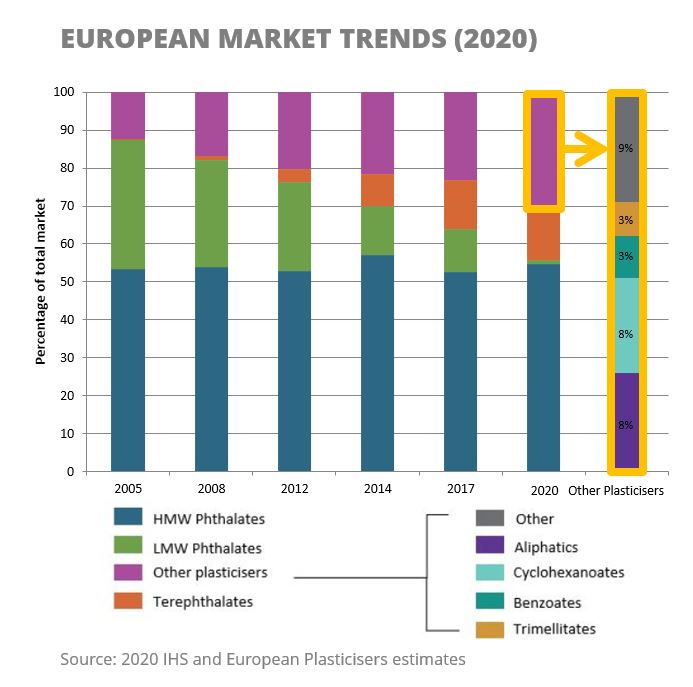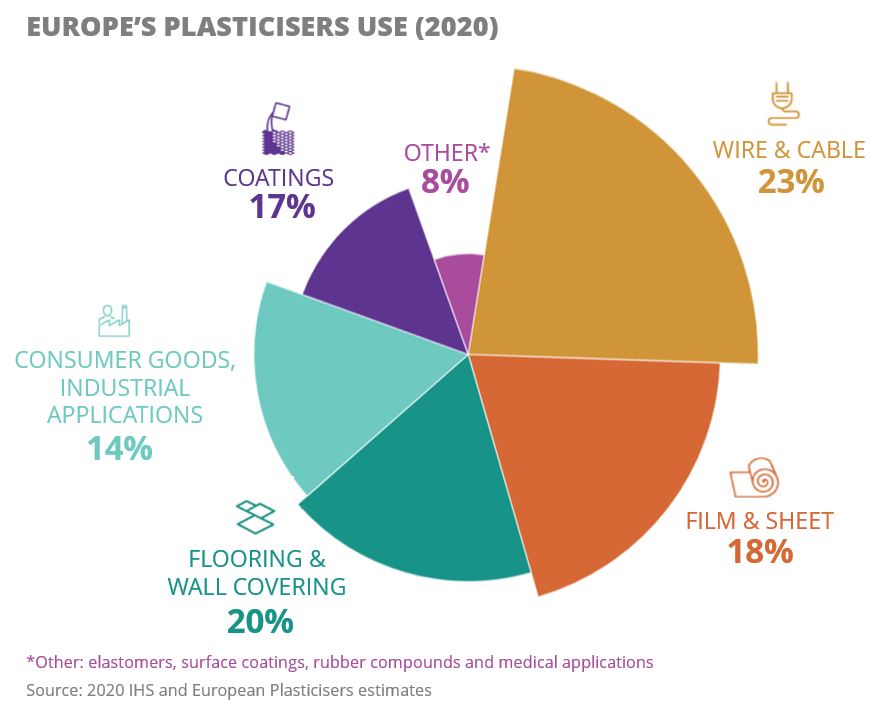Phthalates (pronounced THAL-ates \ˈtha-ˌlāts\) – covering ortho-phthalates – are the most commonly used plasticisers (US: plasticizers) in the world. In Europe, about one million tonnes of ortho-phthalates and terephthalates are produced each year – about 80% of the entire plasticisers market – of which approximately 95% are used to make flexible polyvinyl chloride (PVC). They can be found in a range of everyday items including electrical cables, hoses, flooring, wall coverings, coated textiles, luggage, sports equipment, roofing membranes, pool liners, footwear as well as life-saving medical devices such as tubing and blood bags. In addition, some phthalates are used in non-PVC applications such as coatings, rubber products, adhesives and sealants.
Ortho-phthalates are manufactured by reacting phthalic anhydride with alcohol(s) ranging from methanol and ethanol (C1/C2) up to tridecyl alcohol (C13). Ortho-phthalates are broadly divided into two main distinct groups: LMW and HMW ortho-phthalates with very different applications, toxicological properties, classification and legal requirements.
High molecular weight ortho-phthalates

High molecular weight (HMW) or high ortho-phthalates include those with 7-13 Carbon atoms in their chemical backbone, which gives them increased permanency and durability. The most common types of high ortho-phthalates include DINP, DIDP, DPHP, DIUP, and DTDP.
High ortho-phthalates represent just over 50% of the European plasticisers market. Risk assessments have shown positive results regarding the safe use of this group of substances. They all have been registered for REACH and do not require any classification for health and environmental effects, nor are they on the Candidate List for Authorisation. High phthalates are not CMR, neither are they considered endocrine disruptors. Precautionary restrictions for toys and childcare articles which can be placed in the mouth exist for DINP and DIDP, based on liver effects at high doses observed in rat studies (please note that this is not for reproductive effects!).
High ortho-phthalates are commonly used in PVC products such as wire and cables, flooring, truck tarpaulins, wall coverings, self-adhesive films or labels, synthetic leather, coated fabrics, technical foils, roofing membranes and automotive applications.
Other ortho-phthalates
There are other kinds of ortho-phthalate plasticisers with less than 3 carbon atoms in their backbone (e.g. DMP, DEP,). They are used in very specific applications not related to PVC at all e.g. household and personal care products. For example, the non-classified ortho-phthalates, DMP and DEP are the most widely used in cosmetics in the EU. They have not been classified or restricted because they do not pose any risks for our health or the environment.
NUMEROUS APPLICATIONS & EXTENSIVE TESTING

Today, over 85 percent of all plasticisers consumed in Europe are used in flexible PVC applications. They give PVC the flexibility and elasticity needed for many different applications, particularly in construction (sheathing for electric cables, roofing membranes, flooring and wall coverings), in the automobile industry (trim, cables, under body sealants), furniture and artificial leather goods. Plasticisers are major functional substances that transform the physical properties of PVC and other polymers creating a whole new world of flexible and durable applications.
Because plasticisers (US: plasticizers) are so widely used, they have undergone extensive testing for possible health and environmental effects and are amongst the most widely researched of all chemical substances. In Europe, the safe use of plasticisers is enabled by REACH, the most comprehensive product safety regulation anywhere in the world.
EUROPEAN & GLOBAL MARKET

Globally, 7.5 million tonnes of plasticisers (US: plasticizers) are consumed every year, of which European consumption accounts for over 1.3 million tonnes. Ortho-phthalates, due to their high degree of compatibility with PVC, are the most widely consumed plasticisers. As can be seen from these figures, major plasticisers are high volume commodity chemicals, which take decades and billions of Euros to achieve full commercial development.
In Europe, ortho-phthalates – also know simply as phthalates (LMW and HMW) – make up for the majority of the plasticisers market followed by aliphatics and cyclohexanoates. However, DEHP (LMW) still makes for almost 40 percent of the global consumption because it is still widely produced and used in China, India, and other parts of Asia, the Middle East, Africa and Latin America. The graphs below show this distribution in the European market as a whole and specifically in Western Europe.
| Category | Name | Acronym | Cas | EC | Produced by members | Applications | Classification |
|---|---|---|---|---|---|---|---|
| Ortho-phthalate | Di-C16-18 alkyl phthalate | 90193-76-3 | 290-580-3 | No | Cables and wires | Not class. | |
| Ortho-phthalate | Benzyl C7-9-branched and linear alkyl phthalate | 68515-40-2 | 271-082-5 | No | Flooring, Adhesives & Sealants | Not class. | |
| Ortho-phthalate | Diisotridecyl phthalate | DTDP | 68515-47-9 | 271-089-3 | Yes | Cables and wires, Automotive | Not class. |
| Ortho-phthalate | Diisoundecyl phthalate | DIUP | 85507-79-5 | 287-401-6 | Yes | Cladding and Roofing, Cables and wires, Automotive | Not class. |
| Ortho-phthalate | Di(2-propyl heptyl) phthalate | DPHP | 53306-54-0 | 258-469-4 | Yes | Flooring, Wall coverings, Cladding and Roofing, Cables and wires, Film and sheet, Automotive , Tubes & Hoses, Coated Fabrics | Not class. |
| Ortho-phthalate | Diisodecyl phthalate | DIDP | 68515-49-1 | 271-091-4 | Yes | Flooring, Cladding and Roofing, Cables and wires, Film and sheet, Automotive , Tubes & Hoses, Coated Fabrics, Inks and waxes | Not class. |
| (second DINP line) | 68515-48-0 | 271-090-9 | Yes | ||||
| Ortho-phthalate | Diisononyl phthalate | DINP | 28553-12-0 | 249-079-5 | Yes | Flooring, Wall coverings, Cladding and Roofing, Cables and wires, Film and sheet, Automotive , Tubes & Hoses, Coated Fabrics, Inks and waxes | Not class. |
| Ortho-phthalate | Bis(2-ethylhexyl) phthalate | DEHP | 117-81-7 | 204-211-0 | Yes | Repr. 1B | |
| Ortho-phthalate | Diisooctyl phthalate | DIOP | 27554-26-3 | 248-523-5 | No | Repro. 1B | |
| Ortho-phthalate | Di-n-octyl phthalate | DNOP | 117-84-0 | 204-214-7 | No | Not class. | |
| Ortho-phthalate | Diisoheptyl phthalate | DIHP | 71888-89-6 | 276-158-1 | No | Repr. 1B | |
| Ortho-phthalate | Dicyclohexyl phthalate | DCHP | 84-61-7 | 201-545-9 | No | Flooring, Toys | Repr. 1B |
| Ortho-phthalate | Diisohexyl phthalate | DHP | 146-50-9 | 271-093-5 | No | Repr. 1B | |
| Ortho-phthalate | Di-n-hexyl phthalate | DNHP | 84-75-3 | 201-559-5 | No | Repr. 1B | |
| Ortho-phthalate | Di-n-pentyl phthalate | DNPP | 131-18-0 | 205-017-9 | No | Repr. 1B + Aquatic Acute 1 | |
| Ortho-phthalate | Benzyl butyl phthalate | BBP | 85-68-7 | 201‐622‐7 | No | Flooring | Repr. 1B + Aquatic Acute 1 + Aquatic Chronic 1 |
| Ortho-phthalate | Diisobutyl phthalate | DIBP | 84-69-5 | 201-553-2 | No | Automotive , Adhesives & Sealants, Inks and waxes | Repr. 1B |
| Ortho-phthalate | Di-n-butyl phthalate | DBP | 84-74-2 | 201-557-4 | Yes | Flooring, Automotive , Inks and waxes | Repr. 1B + Aquatic Acute 1 |
| Ortho-phthalate | Di-n-propyl phthalate | 131-16-8 | 205-015-8 | No | Not class. | ||
| Ortho-phthalate | Diethyl phthalate | DEP | 84-66-2 | 201-550-6 | Yes | Adhesives | Not class. |
| Ortho-phthalate | Dimethyl phthalate | DMP | 131-11-3 | 205-011-6 | Yes | Adhesives | Not class. |
